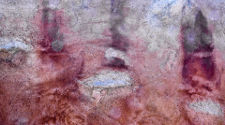
The LCS project is a collaboration between JAEA, Nagra, NDA, Posiva and SKB, aimed at increasing our understanding of the interactions of cement with other engineered barrier materials and with potential host rocks.
Quintessa (in association with Savage Earth Associates Limited) has been working in collaboration with the NDA on LCS for a number of years, providing geochemical modelling support.
The latest phase of the LCS project has involved using data from natural and industrial analogue sites such as Tournemire (France) as a basis for testing our understanding, data and models for cement and concrete based systems and cement-rock reactions. At Tournemire boreholes have been drilled into the base of a tunnel and subsequently filled with concrete. This has been in contact with a mudstone for a period of 15-20 years, and a volume fraction plot (white indicates porosity) of the simulation results after 15 years of alteration can be seen on the left. Work has been undertaken by IRSN in France to overcore these boreholes and analyse samples in the laboratory, an example of which can be seen below. The mineralogical alteration is clearly visible. Further information can be found on the project page on the IRSN website.
Each of the LCS modelling teams has applied their own geochemical models and codes to the Tournemire site. An important part of this modelling exercise is determining which processes are important within the system, such as mineral dissolution/growth kinetics, ion exchange and surface complexation. The modelling work by Quintessa has produced a good fit to the observations of the mineral characterisation studies, with ion exchange and surface complexation playing an important role in regulating the extent of the pH plume in the mudstone. Further details of the LCS Project can be found on the GTS website.